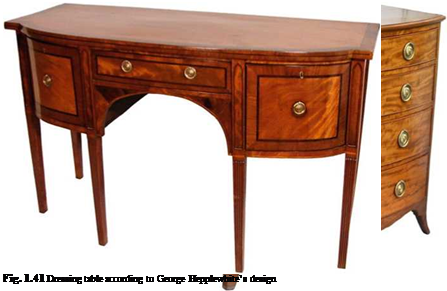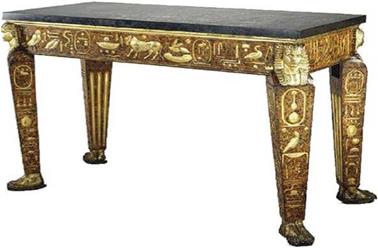The empire style in France evolved as a symbol of Napoleon I’s Empire, based on turbulent political and social changes. Empire furniture has a monumental, compact, heavy and massive form. Straight lines and mostly flat surfaces prevail here.
Case furniture was equipped with a wide, massive base that emphasised grandeur and lack of mobility. Usually, they were veneered with dark-red mahogany, which was contrasted with gilded browns and wood carved ornaments, inlay was
 |
rarely encountered. The French empire caused the creation of new types of cabinets and bookcases, as well as new constructions which were sometimes glass-cased on three sides for china. Separate case furniture constituted chests of drawers and chiffoniers, which served mainly to store underwear and other trinkets, as well as
|
Fig. 1.42 Rectangular table with legs directly on the floor |
escritoires which were used for writing and storing. Empire desks almost entirely preserved their style from the previous era, and only minor details and decorations are the result of interactions with contemporary trends.
Tables were made in different variations and sizes, including dining room tables, tables for flowers, coffee and tea tables, toiletry tables, tables for women’s knitting, as well as tables with wash basins. The worktops of these constructions were characterised by a round, rectangular or polygonal shape (Fig. 1.42).
The legs of the Empire table do not always rest directly on the floor, but on supports in the shape of a board or multi-pointed stars. They usually have the form of columns, human and animal figures or a structure based on Roman models, including the winged female figure emerging from a lion leg.
Chairs, armchairs and other furniture for sitting differ slightly from those produced in the period of Louis XVI, they are heavier and more massive. It can be noticed that usually the front legs differ from the rear legs. They form a straight line and come right up to the armrest supported by a shape of an Egyptian woman’s head, woman’s bust, winged lions or swans (Fig. 1.43). Large carved figures of women mostly fulfilled the function of a table’s legs, while the figures of Sphinxes were supported for the armrests of chairs and armchairs. Many armchairs also had spheres by the armrests.
Sofas were decorated with the silhouettes of swans with high outspread wings. In representative furniture, the seat and backrest were covered with silk fabrics, carpets and embroidered gobelin fabrics threaded with a gold tinsel.
Luxury beds were mostly built on a podium along with a magnificent canopy, from which drapes trimmed with gold dropped (Fig. 1.44). The connectors and posts were finished off with classic urns and vases made of bronze or gilded wood. Other beds usually did not have a canopy.
Fig. 1.43 Armchair made of beech wood, around 1830 (Louvre Museum, Paris)




